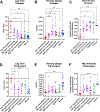Concizumab improves clot formation in hemophilia A under flow
- PMID: 38815755
- PMCID: PMC11343664
- DOI: 10.1016/j.jtha.2024.05.020
Concizumab improves clot formation in hemophilia A under flow
Abstract
Background: Inhibition of tissue factor pathway inhibitor (TFPI) is an emerging therapeutic strategy for treatment of hemophilia. Concizumab is a monoclonal antibody that binds TFPI and blocks its inhibition of factor (F)Xa thereby extending the initiation of coagulation and compensating for lack of FVIII or FIX.
Objectives: The objective of this in vitro study was to evaluate how concizumab affects clot formation in hemophilia A under flow.
Methods: Blood was collected from normal controls or people with hemophilia A. An anti-FVIII antibody was added to normal controls to simulate hemophilia A with inhibitory antibodies to FVIII. Whole blood and recombinant activated FVII (rFVIIa, 25 nM) or concizumab (200, 1000, and 4000 ng/mL) were perfused at 100 s-1 over a surface micropatterned with tissue factor (TF) and collagen-related peptide. Platelet and fibrin(ogen) accumulation were measured by confocal microscopy. Static thrombin generation in plasma was measured in response to rFVIIa and concizumab.
Results: Concizumab (1000 and 4000 ng/mL) and rFVIIa both rescued (93%-101%) total platelet accumulation, but only partially rescued (53%-63%) fibrin(ogen) incorporation to normal control levels in simulated hemophilia A. Results using congenital hemophilia A blood confirmed effects of rFVIIa and concizumab. While these 2 agents had similar effect on clot formation under flow, concizumab enhanced thrombin generation in plasma under static conditions to a greater extent than rFVIIa.
Conclusion: TFPI inhibition by concizumab enhanced activation and aggregation of platelets and fibrin clot formation in hemophilia A to levels comparable with that of rFVIIa.
Keywords: blood coagulation; hemophilia A; hemorheology; lipoprotein-associated coagulation inhibitor; microfluidics.
Copyright © 2024 International Society on Thrombosis and Haemostasis. Published by Elsevier Inc. All rights reserved.
Conflict of interest statement
Declaration of competing interests There are no competing interests to disclose.
Figures





References
-
- Srivastava A, Santagostino E, Dougall A et al. WFH Guidelines for the Management of Hemophilia, 3rd edition. Haemophilia. 2020;26 Suppl 6 1–158. - PubMed
MeSH terms
Substances
Grants and funding
LinkOut - more resources
Full Text Sources
Medical
Miscellaneous

